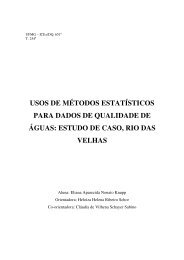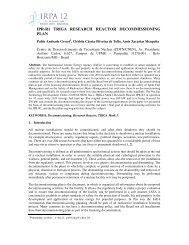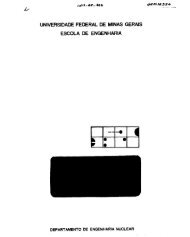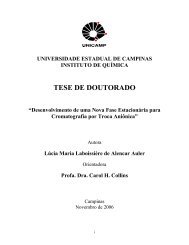thermocouples recovery of one triga instrumented fuel rod ... - CDTN
thermocouples recovery of one triga instrumented fuel rod ... - CDTN
thermocouples recovery of one triga instrumented fuel rod ... - CDTN
You also want an ePaper? Increase the reach of your titles
YUMPU automatically turns print PDFs into web optimized ePapers that Google loves.
Fig. 6. Place <strong>of</strong> the rupture <strong>of</strong> the <strong>thermocouples</strong> in the <strong>instrumented</strong> <strong>fuel</strong> element<br />
4.1 Removal <strong>of</strong> the stainless steel shield <strong>of</strong> the <strong>thermocouples</strong><br />
The methodology used for removal <strong>of</strong> the <strong>thermocouples</strong> shield was by an electrical pulse<br />
adjusted to burn only the stainless steel that covering the <strong>thermocouples</strong> [6]. Electrolytic<br />
capacitors had been loaded and its load was used to burn the shield. To find the correct<br />
value <strong>of</strong> electric charge, some preliminary tests with <strong>thermocouples</strong> <strong>of</strong> the same diameter <strong>of</strong><br />
the IF <strong>thermocouples</strong> was used (1.0 mm). It was confecti<strong>one</strong>d two copper elect<strong>rod</strong>es with a<br />
groove <strong>of</strong> 1 mm in order to accommodate the thermocouple before the electric pulse.<br />
After the removal <strong>of</strong> the steel shield, the magnesium oxide (MgO) can be easily removed<br />
with aid <strong>of</strong> a clamp. In this way the two <strong>thermocouples</strong> element wire had been accessible.<br />
Figure 7 shows the assembly used for to remove the <strong>thermocouples</strong> shield.<br />
Fig. 7. Assembly used for removal <strong>of</strong> the <strong>thermocouples</strong> shield by electric charge








